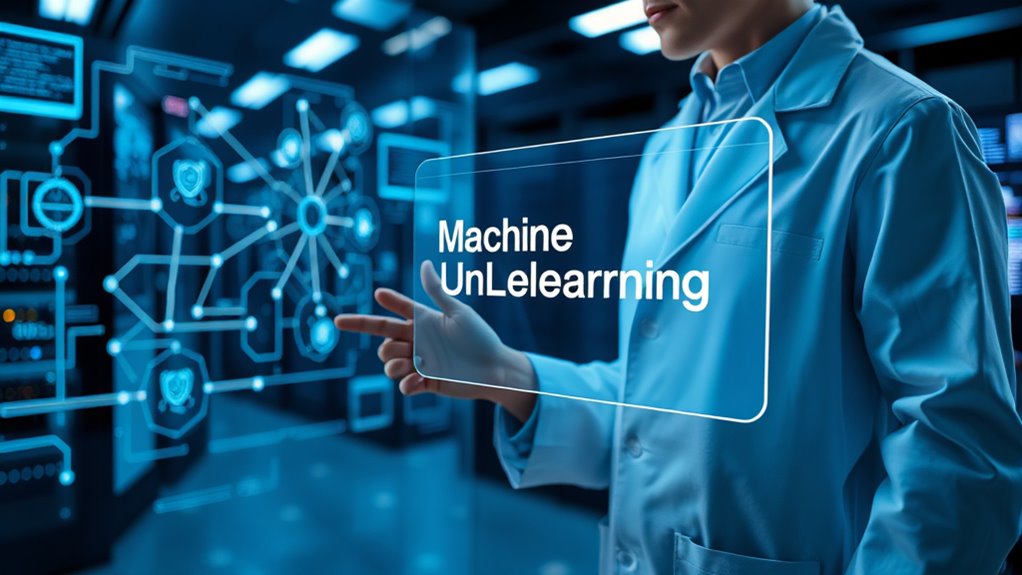Machine unlearning is a vital approach to protect your data privacy in AI models. It allows you to remove specific data points entirely, without needing to retrain the entire model from scratch. This process guarantees that the model forgets certain information, preventing residual influence on its outputs. By using targeted and efficient techniques, you can maintain model performance while complying with privacy laws like GDPR and CCPA. Discover how these methods work and their benefits if you continue exploring this topic.
Key Takeaways
- Machine unlearning enables AI models to completely remove knowledge of specific data, ensuring privacy compliance.
- It uses targeted parameter updates or mathematical techniques to efficiently forget data without full retraining.
- Unlearning addresses residual data influence, preventing unwanted information from affecting model outputs.
- It balances effective data removal with maintaining model accuracy and operational efficiency.
- Implementing unlearning helps meet legal regulations like GDPR and CCPA, protecting user privacy.

As artificial intelligence systems become more integrated into our lives, the need to remove specific data from their training sets has grown increasingly urgent. You might wonder why this is necessary. The answer lies in privacy concerns, legal regulations, and the ethical responsibility to protect individuals’ sensitive information. When a user requests data removal, it’s not enough to simply delete the data from storage. The AI model itself can retain knowledge of that information, which could influence its responses or decisions. This is where the concept of machine unlearning comes into play. It aims to guarantee that once data is removed, the model forgets it entirely, preventing any residual influence on its outputs.
Implementing data removal isn’t as simple as deleting a file. Traditional approaches involve retraining the model from scratch using only the remaining data, but this can be computationally expensive and time-consuming. Instead, you can perform model retraining techniques that selectively update the model’s parameters, removing the influence of the data in question without starting over completely. This process requires sophisticated algorithms that identify and eliminate the learned knowledge associated with specific data points, effectively “unlearning” them. By doing so, you maintain the model’s performance while guaranteeing compliance with privacy requests.
Model unlearning updates only relevant parameters, avoiding costly full retraining while ensuring privacy compliance and maintaining performance.
Model retraining for data removal is a delicate process. It involves analyzing how particular data points have shaped the model’s behavior and then adjusting the parameters accordingly. You need to ascertain this adjustment doesn’t inadvertently degrade the overall accuracy or introduce bias. Advanced machine unlearning methods leverage mathematical frameworks that pinpoint the contribution of specific data during training. Once identified, the model undergoes targeted updates, removing the influence of the data without sacrificing its generalization capabilities. Incorporating efficient algorithms can help optimize this unlearning process, making it more feasible for large-scale systems.
The challenge is balancing efficiency with effectiveness. Fully retraining a model every time a data removal request occurs isn’t practical, especially for large-scale systems. Consequently, you must adopt approximate or incremental unlearning techniques that are fast yet reliable. These methods are designed to perform the necessary data removal while minimizing computational resources and time. By integrating such techniques into your AI workflows, you can uphold privacy standards, comply with regulations like GDPR or CCPA, and maintain user trust—all without sacrificing model performance.
Frequently Asked Questions
How Does Machine Unlearning Impact AI Model Accuracy?
Machine unlearning can markedly reduce your AI model’s accuracy because it removes specific data, which may affect model generalization. However, if done correctly, it helps mitigate data bias, ensuring fairer outcomes. You might notice some trade-offs, but unlearning improves data privacy without significantly compromising overall performance. By carefully balancing these factors, your model stays reliable while protecting user information.
What Are the Main Technical Challenges in Implementing Unlearning?
Think of unlearning like untangling a knot—you face tricky technical challenges. You need to manage model complexity while maintaining accuracy, which is no easy feat. Computational efficiency is essential; if unlearning takes too long or uses too many resources, it becomes impractical. Balancing these factors is tough, requiring innovative algorithms that can efficiently remove data influence without compromising the model’s overall performance.
Can Unlearning Completely Erase Specific Data From All Models?
You can’t always guarantee complete Data removal from all models through unlearning. While some techniques allow you to remove specific data, they often require Model retraining to confirm the data no longer influences predictions. However, this process can be imperfect, and residual information might remain. So, unlearning may reduce data influence considerably, but it might not guarantee total erasure in every case.
How Does Unlearning Differ From Traditional Data Deletion Methods?
You might be surprised to learn that traditional data deletion leaves residual traces in models, making complete removal tough. Unlike simple data deletion, unlearning actively removes specific data from the model, often without retraining from scratch. This process guarantees better data privacy and compliance. While data retention can be minimized, unlearning offers a targeted approach, reducing the need for costly model retraining and enhancing overall privacy safeguards.
What Industries Are Most Affected by Machine Unlearning Requirements?
You’ll find healthcare and finance industries are most impacted by machine unlearning requirements. Healthcare compliance demands that patient data be removable to protect privacy, while financial regulations require deleting sensitive information to prevent misuse. By implementing machine unlearning, you guarantee AI models respect these rules, maintaining trust and legal adherence. This proactive approach helps prevent data breaches and supports regulatory compliance, making it essential for these highly regulated sectors.
Conclusion
By understanding machine unlearning, you can protect privacy, enhance trust, and guarantee compliance. By removing data responsibly, you prevent misuse, preserve integrity, and promote transparency. By embracing unlearning techniques, you empower your AI models to adapt, to respect, and to safeguard. Ultimately, you create a future where data privacy is prioritized, where models are trustworthy, and where your responsible AI practices set new standards. Together, you build a safer, more ethical, and more reliable AI environment.










